What Techniques Should Be Used When Making Baby Food
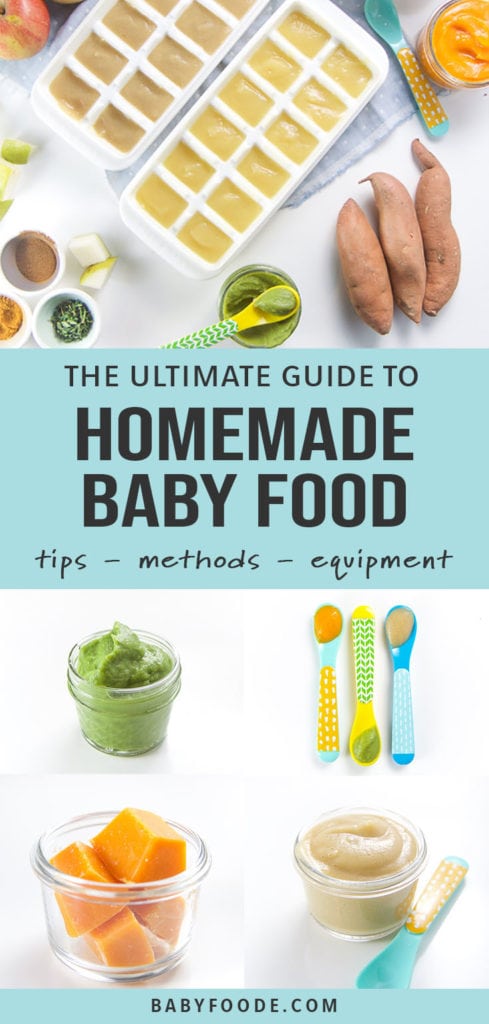
Here it is, the Ultimate Guide on How to Make Your Own Babe Food! Everything you need to know to get started on making homemade baby purees is right in this guide. Tips, tools, storage methods, recipe combinations, starter purees, introducing new foods — proper name information technology, and you'll find information technology here! This in-depth guide is perfect for babies ages 4-6+ months!
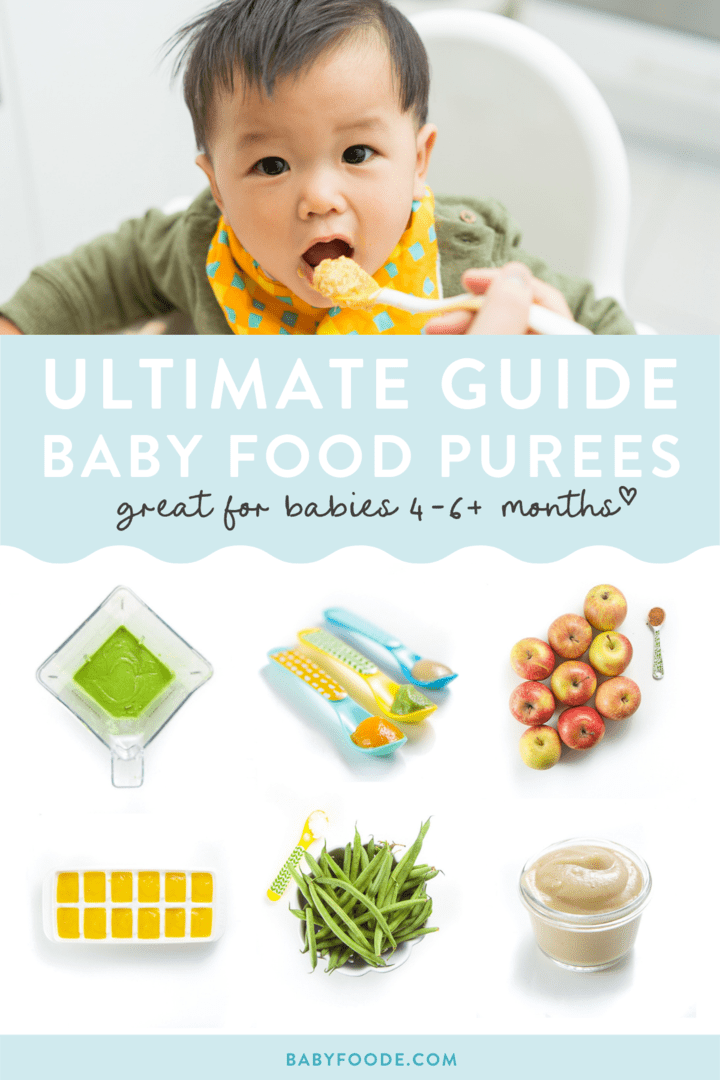
Medically reviewed and co-written by Jamie Johnson, Registered Dietitian Nutritionist (RDN), and Lauren Braaten, Pediatric Occupational Therapist (OT).
Purees for Baby
Are yous wanting to make your infant homemade infant nutrient purees but don't know where to offset?
In this guide I'll share everything y'all demand to know to brainstorm, starting from the best cooking tools to have on hand and safe storage. I volition too share how to know when infant is ready for solids, how to introduce purees, the best first foods for baby, starter purees, and more than! They're all ideal for babies at least iv months quondam (phase 1 baby food). You can as well cheque out my all-time-selling cookbook for even more than information and recipes!
In short, this comprehensive guide will teach yous how to make and serve homemade babe food without stressing out near it.
That's the key hither —don't stress out. It's supposed to be fun, and it'due south going to be! Hopefully, after going through this guide, you lot'll realize that making bootleg baby food is every bit piece of cake as pie. Plus, seeing your baby wanting to devour your appetizing homemade purees is a priceless moment that is worth the work.
Here's a tip: Grab a cup of coffee (or glass of wine), and break this mail service down into smaller sections and so you can assimilate it (pun intended) over time.
As you lot kickoff making your own baby food purees, you'll realize that this once daunting task can actually become 2d nature to yous. Don't panic, y'all've got this!
Guide on Baby Nutrient Purees Video
Watch this video to observe out more about how to freeze, store and thaw your own purees!
5 Reasons to Make Your Own Baby Nutrient
Present, it's easy to buy food for your babe. Many brands now tout that their baby food purees, pouches, and snack bars are organic. Given that yous practice have a choice, why should you cook at home?
TASTE
Nothing tastes better than a healthy, homemade meal, and that goes for baby purees every bit well.
- Tastes Better – Nutrient always tastes better using fresh, wholesome ingredients.
- Tastes Existent – If yous want your infant to feel what a real apple tree tastes like, and then make a babe nutrient puree using real apples. The industrial process of making store-bought baby food kills off most of the flavors, nutrients, and aromas of the produce, making purees gustation bland and unnatural.
- Tastes Fresh – Most commercial baby food purees are heated to extremely loftier temperatures to have upward of three-year shelf life. That means the food from the store is most likely older than your baby.
Don't get me wrong — shop-bought babe food is convenient if you are in a compression. Only you can't beat the taste of whatever bootleg baby food.
TEXTURE
The ability to control the thickness of your baby'southward puree is an advantage that volition not just help you go through the picky-eating days but too help transition your baby from purees to solid food.
- Some babies adopt thinner purees, while other babies like thicker ones. When yous make your own, you are in control of how thin or thick your baby's puree will exist.
- Different textures are as new to your baby as the flavors themselves. So, varying a puree'southward texture will not only requite your baby a new eating experience only will too excite their taste buds.
Diet
Homemade baby food is undoubtedly healthier for your babe than any brand of store-bought food, whether jarred or in pouches. But the biggest nutrition win I experience you get is that you can tailor them to your child's needs anytime.
- Is your babe feeling a picayune under the weather? Make a puree loftier in vitamin C.
- Depression on fe? Add some beef, spinach, or beans.
- Maybe your infant is a trivial constipated. Making a puree with anything that starts with a "P" — pears, prunes, peas, peaches — volition before long become your little one back on their adorable feet.
QUALITY CONTROL
Since you're the one who buys the ingredients and handles, preps, and cooks the purees, you can residual assured that yous know exactly what's going into all of your baby's food.
What yous make is what your babies go! There are no fillers, thickeners, suspicious ingredients with names yous tin't pronounce, shelf stabilizers, or unnecessary water. Just healthy, flavorful homemade baby nutrient that you tin can besides enjoy!
COST SAVINGS
Lastly, this might come as a surprise, but making your own infant food with all organic ingredients is more than than 50 percent cheaper than buying their store-bought counterpart!
Depending on how much your baby eats, homemade baby purees tin can salve you some serious money.
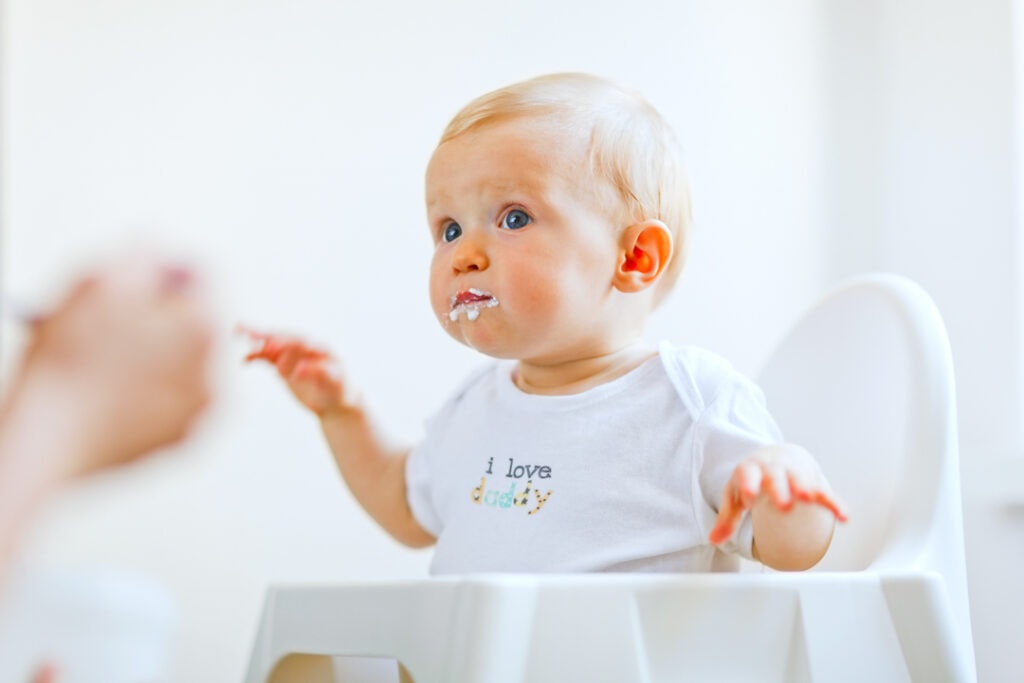
What is Traditional Weaning
Traditional weaning (as well sometimes called "spoon-feeding") involves introducing nutrient to your baby via puree form first and so gradually progressing the texture and types of foods over time. Since food is pureed with traditional weaning, the parent typically needs to spoon-feed their babe. Initial foods offered with this approach typically include sparse, shine purees, such as fruits, vegetables, oatmeal or rice cereal. Textures gradually progress to thicker purees, then mashed or chopped foods, and eventually soft finger foods, such every bit cooked vegetable pieces, toast, pasta, and meats.
Benefits of Traditional Weaning/Spoon Feeding
- Baby learns how to swallow safely first, so works on chewing skills later. Purees tin be very helpful for teaching swallowing, as they assistance intrinsic tongue muscles develop, preparing your baby to chew and swallow more than efficiently. It's also less mutual to gag or choke on purees, which may assist some babies experience more comfortable when starting the feeding process.
- You know how much your infant has eaten.Whether using store-bought or homemade purees, you'll be able to go a expert guess on how much your baby consumed.
- Babe tin get a lot of flavor from the start. Who says purees take to be boring and bland? Especially if you make homemade purees, there are some pretty tasty season combinations that you can offer baby as some of their first foods.
- Less Mess (well, maybe). Although letting baby touch and explore foods is an important part of the process, if you're feeling hesitant on but how messy things are going to get initially, starting with spoon-feeding purees might assistance y'all ease into the process.
Challenges of Traditoinal Weaning/Spoon Feeding
- Preparing lots of dissimilar purees can exist time consuming.In add-on to making other meals for yourself and the rest of the family, information technology might feel challenging to make separate meals just for your infant. Although with bootleg purees, you will ofttimes make a big enough batch and so that you'll have several weeks' worth of nutrient.
- Spoon feeding infant can make information technology tough to feed yourself during a family fashion repast.Sitting and eating when baby eats is possible, but you volition likely take many interruptions as you pause to spoon-feed infant throughout the meal.
- Babe won't get as much opportunity to engage in sensory exploration.Unless you progress to giving baby their own basin or spreading purees on the tray and encouraging baby to taste the nutrient off their fingers, they won't become every bit much opportunity to feel the puree on their hands, fingers, and face.
- Feeding baby by signs of fullness.Reading baby'due south cues is of import no matter what arroyo you're using, but at that place can be a tendency to go on to feed babe past signs of fullness when spoon-feeding and sneak in "just one more bite" from that almost empty container.
- Getting "stuck" in a comfortable zone.Once baby seems to take mastered taking purees from a spoon, information technology can go tempting to stick with what you know. But baby tin can go as well comfortable with the smoothen texture of purees if not encouraged to progress to other textures. This may lead to difficulties managing these textures afterward on in life.
When is Infant Ready for Solids
Whether you decide to get with traditional weaning (purees), infant-led weaning or a combination of both,look for these readiness signs in your babe:
- Effectually six months of age
- Sitting with minimal assist
- Skilful control of their head and body
- Bringing easily and toys to their mouth
- Appears interested in food, possibly by reaching for or leaning forward towards food
Before y'all get-go weaning your baby, you should consult with your pediatrician to make sure your child is developmentally ready.
Fortunately, nearly of the tools you demand to brand homemade infant food tin can already be found in your kitchen. Score!
Tools Needed
- blender or nutrient processor
- baking sheet
- saucepans
- knives
- veggie peeler
- spatula
- freezer tray
- storage containers for fridge
- stasher handbag
- reusable pouches
- baby food maker
Baby Feeding Essentials
- highchair
- suction basin or infant basin
- baby spoon
- open lid cup
- bib with catch pocket
- sleeved bib
- splat mat to cover the flooring
Learning Resource: looking for the best high chair, cups or spoons for your baby? Then nosotros've got you lot covered! Here y'all will find How to Discover the Best High Chair for Babe, an like shooting fish in a barrel guide on Best Commencement Open Cups for Babe (plus iv tips when introducing a cup) too as three Tips on How To Spoon Feed Baby (plus – our favorite spoons for purees or BLW).
How to Brand Baby Food Purees
All of the baby food recipes on my weblog and in my cookbooks are designed to raise the natural taste of the fruits and veggies while keeping equally many nutrients intact as possible. In other words, the goal is to brand a puree that's both healthy and delectable.
There are several ways you can melt baby nutrient purees, just the main techniques I use are:
- Steaming
- Roasting
- Simmering
- Raw
Keep in mind, that as long equally the produce is cooked until soft, that at that place isn't a right or wrong way to cook information technology for baby food.
If a recipe for broccoli calls for steaming but you want to roast information technology considering you will already be roasting some broccoli for yourself for dinner, and so get ahead and roast the broccoli for your baby'southward puree. Play around and have some fun with it!
Adding Spices to Infant Purees
It'south encouraged that yous tin serve your baby a homemade puree with a pinch of spices or herbs from the very get-go bite.
Benefits of Spices
- heave and compliment whatsoever fruit or vegetable puree
- broaden babe's emerging palate
- add more than flavour and depth into their foods
- decrease picky eating in the years to come
- have medicinal properties in them — they can help with digestive issues, boost encephalon functions, repair muscle tissues, then on.
While each puree recipe on this site has a selection of spices or herbs that complement the flavors of the fruit or vegetable in the puree, it'south upwardly to yous if you want to add together them. Y'all exercise you! Either way, the puree recipes on this site will exist succulent.
Top Spices to Add together to Baby's Puree
- Cinnamon
- Cloves
- Nutmeg
- Basil
- Mint
- Parsley
- Balmy Curry Powder
- Fresh Lemon Juice
- Garlic
- Rosemary
How To Blend Infant Nutrient
Pureeing homemade babe nutrient is a very straightforward event. Withal, it can take some practice to get the smoothest, creamiest puree for your baby.
Pace-by-Stride Instructions
- Place Produce In Blender: place cooked produce into a blender or food processor.
- Beginning Machine: turn the machine starting on depression and increasing until you reach the highest setting.
- Add Liquids: add liquids (water, fresh breast milk or formula) in pocket-size increments if needed to help smoothen out the puree. Root veggies may been up to a cup of liquid while fruits may not need any. Add in one/4 loving cup of liquids at a time to make sure non to add too much liquids.
- Blend: it ordinarily takes 1-2 mintues to fully alloy a puree for baby. If you are getting a chunky puree, add in a little bit more water and keep blending.
Notation on Blending: you will always become a smoother puree when you use a blender over a nutrient processor. Most babies will non notice a difference between the texture of baby food made in a blender versus a food processor but if your baby is having trouble with the texture of a puree made in a food processor, you may want to endeavour using a blender.
Tips for getting the Smoothest Baby Purees
- Requite It Fourth dimension: Give your blender or nutrient processor some time to piece of work its magic. It takes 1-two minutes of blending for each puree to get the smoothest puree. But it may have longer if you have an older blender model or you are using a nutrient processor.
- Add together Liquids: Yous may have to add extra liquids like h2o, fresh breast milk, or formula into the blender or food processor in lodge to go the blender really going. Hard root vegetables like carrots, sugariness potatoes, beets, etc., oft take at least 1-2 cups of liquids because they do non have loftier water content. I recommend adding liquid into the blender in 1/4 cup increments or smaller so you don't get a runny puree.
- Cyclone Outcome: You will know you accept the right corporeality of liquid and are at the correct speed when y'all get the cyclone effect. This is when all the ingredients are completely circling the blending without whatever interference.
- Scrape Down Sides: While blending, make sure to scrape the sides with a spatula to get all the produce and spices incorporated into the puree.
- Blender vs. Nutrient Processor: A high-speed blender will give yous the smoothest puree. A food processor will too work just the result is a slightly thicker puree. The upside of the nutrient processor is that you don't have to add as much liquid to the puree.
Just Starting: Roasted sweet potato and 1/2 cup of water.
xxx Seconds: Scraped down the sides and added ane/4 cup more of h2o.
60 Seconds: Scraped down the sides and added one/4 cup more than of h2o.
90 Seconds: Added 2 tablespoons of h2o, and it was perfect. The puree was conspicuously running through the blender and the puree was getting super smooth.
Finished: A polish puree for the win!
See the video in this postal service to become a step-past-stride look at how to blend babe food.
How to Freeze, Store & Thaw Babe Purees
Your freezer is most to become your new best friend, allowing you to keep several weeks' worth of infant purees at the ready.
How to Freeze Babe Food
Whenever you make a puree, put several ounces in the fridge for your little one to enjoy that week, then freeze the rest of the batch for your baby to eat at a later date. Please make sure you become it in the puree into the fridge or freezer within 1 hour of cooking to prevent bacteria growth.
- Make a puree.
- Let it absurd slightly.
- Transfer the puree to freezer trays or freezer jars.
- Cover the freezer trays with a lid or plastic wrap.
- Characterization with date and proper noun of puree.
- Place the tray in the freezer.
- Let it freeze for at least 5 hours.
- Take the tray out of the freezer.
- Crevice the purees out of the trays.
- Place the frozen purees into nothing-lock baggies or stasher bags.
How to Store Babe Nutrient
Purees tin be stored for up to four days in an airtight container in the fridge or 4 months in the freezer.
How to Thaw Babe Nutrient
Thawing may seem like a no-brainer, but it never hurts to know your options. In that location are iii different ways to thaw purees.
Microwave
- Take the frozen puree cubes that you want to serve out of your freezer.
- Place them in a glass microwave-safe container.
- Microwave in twenty-second increments, stirring every time.
- The puree is ready when it is only warm to your affect.
- Grab two clean spoons, one for y'all and one for your babe, and test your puree before serving.
Heating Tip: To prevent the microwave from unevenly heating the puree, which can leave it with cold and really hot spots and tin burn down your baby's oral cavity, make sure you stir between each interval and gustation test it before serving to your baby.
Fridge
This one takes the longest fourth dimension, just it is an excellent alternative to using a microwave.
- Take the frozen puree cubes you want to serve out of your freezer.
- Place the cubes in an air-tight glass container.
- Place the container in the fridge and let the cubes thaw for viii to 12 hours, commonly overnight.
- Practise non get out the puree in the container to thaw on the counter or anywhere out of the fridge, every bit leaner will start to grow at a rapid rate — which is definitely not recommended.
- Note that the puree will be cold but thawed. So if your baby likes their puree warmed, you'll have to finish the job using the microwave or stovetop method.
Stovetop
- In a small saucepan, add the frozen puree cubes you want to serve to your babe.
- Over medium-low heat, gently cook the puree until warm, stirring occasionally.
Thawing Tip: Some infants similar their puree cold, warm, or really warm, and some volition eat it no matter the temperature. You will get to know your babe's personal preferences equally the two of you bond over nutrient.
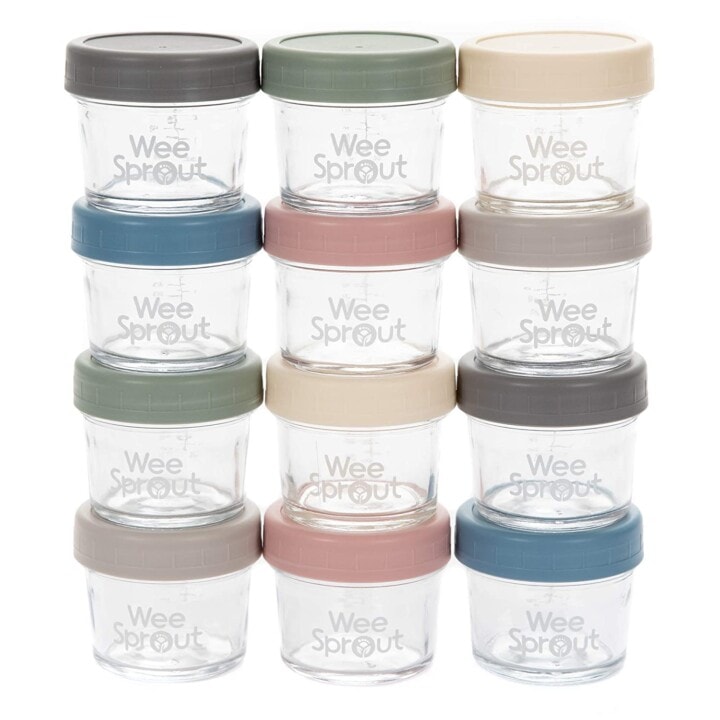
WeeSprout Glass Babe Food Storage Jars
These 4oz containers with lids allow you to gear up the perfect amount of food for your little ones. No more food waste! Made with food-grade glass and a plastic lid. Microwave, freezer, and dishwasher-friendly!
How to Innovate Purees
High chair? Bank check. Bib? Check. Fully charged jail cell phone? Check.
With this holy trinity of infant-feeding accouterment, you're set for that first feed.
The faces, oh, the faces your babe is nearly to brand! Out of all the firsts, feeding is the most fun — and the messiest. So grab a few wipes, double-bank check that your telephone has enough storage for dozens of photos and videos, and allow'south become started!
Before you begin, brand sure your baby has a petty bit of breast milk or formula in their belly, about half of what you'd commonly give in a regular feeding.
Not too total. Non too hungry. Just right.
The Principles
This is not going to be a clean and simple process. Your baby may eat nutrient 1 day, refuse it the next, and paint their face up with it the next. It's all okay. Playing with nutrient is a adept matter; information technology is merely a style for babies to explore, larn, smell, and taste the world effectually them. So have those wipes close past, and call back:
- Start Slowly – Two teaspoons once a 24-hour interval is plenty food for babies for the first couple of meals. Their bodies need fourth dimension to adjust and digest new food. If they are still acting hungry, give them some more than breast milk or formula.
- Let the Infant Decide – Your lilliputian one should decide how fast or wearisome they want to eat.
- All Spoons on Deck – Have more than than one spoon gear up. Your baby will surely snatch one out of your hands to play with, which is a-okay.
- Accept Fun – Smile at your infant throughout the feel, and effort to relax. The more fun you lot accept, the greater the likelihood your babe will enjoy it, too (even if they barely eat or don't eat at all).
- Build Upwards – After a couple of days, build up the quantity of food you offer ane tablespoon at a time.
The Ideal
Are you lot ready to start the feeding? Select a puree you lot've already made. Place just ane or two teaspoons of it into its own bowl and slightly warm this small amount. Y'all can choose whether to gently spoon information technology into your baby's oral fissure or mitt the spoon over to them to attempt cocky-feeding. If your babe tries to catch the spoon from you and gets information technology into their mouth by themselves, whoa — you've got success on your easily. If the experience is a bit milder, and they let you spoon some puree into their mouth, enjoy information technology. This is a winning experience, also.
The Probable
Some babies will simply not open their mouths. Some babies will have ane bite, clamp their mouths, and turn away. If (and when) any of this happens, don't force the spoon into their mouth, and don't stress out. Here are a couple of things to try:
- Put a flake of the puree at the end of your finger and see if your baby will suck it off. This is an unintimidating way to begin, especially as spoons tin exist scary for little ones.
- Pour a tablespoon of puree onto the loftier chair tray, and allow your infant to play with information technology if they want. This is a less micromanaging arroyo to letting the baby explore new nutrient. As babies dearest to put everything in their mouths, odds are at least some will make it (or near) it.
- If your baby has no interest in these options, end the feeding. Dispose of the 1 or 2 teaspoons you warmed. Put the remaining, unheated puree in the fridge to try again tomorrow.
Call back that earlier their first birthday, babies receive their chief source of calories, vitamins, fat, and protein from your chest milk or formula. At this signal, whatsoever puree or solid food you lot give your babe is mainly used to teach them how to eat and explore existent food.
10 Starter First Foods for Infant
Not sure which foods to offer first? These ten foods are nutrient-dumbo, easy to make, and tasty purees are a choice for your babe.
- Avocado
- Banana
- Sweet Potatoes
- Apple tree
- Broccoli
- Pear
- Carrot
- Yogurt
- Oats
- Green Bean

Foods to Avoid
You will want to avoid these foods until your baby is developmentally fix for them:
- Whole nuts, seeds
- Clumps of nut butter
- Dried fruit
- Hard processed
- Hard, raw fruits and veggies
- Popcorn
- Hot dogs
- Whole grapes
- Added table salt and sugar
- Honey until 1 year of age
- Moo-cow's milk until one twelvemonth of historic period
Sample Puree Feeding Schedule
Aim to feed infant a variety of flavors to aid expand her palette, which can help reduce picky eating. Try to brand certain y'all serve at least one atomic number 26-rich food per repast to help prevent iron deficiency anemia. To brainstorm, serve sparse pureed foods that
SAMPLE SCHEDULE FOR half-dozen – 7 Month-OLDS
Nearly babies are set to start purees effectually six months of age. Outset with one-2 meals a 24-hour interval and keep the same amount of formula or breast milk feedings, unremarkably five. Note that there is no i right schedule for your baby.
7am- 7:30-wake-up, bottle/breastfeed
7:30am- 8:30am- play
8:30am- 9am- avocado puree
9am- 10:30am- forenoon nap
10:30am- 11am- bottle/breastfeed
11am- 12pm-play
12pm-2pm- afternoon nap
2pm- 2:30pm-bottle/breastfeed
2:30- 3pm- banana puree
iii- 3pm -play
4pm- 5pm- cat nap
5pm- 5:30pm- bottle/breastfeed
5:30pm- 6:30 pm- play
vi:30pm- bath
7pm-7:30pm- bottle/breastfeed
7:30pm- bedtime
SAMPLE SCHEDULE FOR 8 – 9 Calendar month-OLDS
If your baby is not eating 2 solid meals a solar day yet, go alee and increment purees to twice a solar day. Once y'all have introduced a variety of unmarried-ingredient purees, you can outset offer combination purees.
7am- vii:30am- wake-upwards, bottle/breastfeed
7:30-8:30am- play
8:30am– 9am- apple and carrot puree
9am-10:30am- forenoon nap
ten:30am- 11am- bottle/breastfeed
11am-12pm-play
12pm- 2pm- afternoon nap
2pm- two:30pm- canteen/breastfeed
ii:thirty- 4pm- play
4pm- 5pm- cat nap
5:00pm- 5:30pm- bottle/breastfeed
five:30pm- 6:00 pm- play
six:00pm- 6:30pm- sweetness potato and craven puree, yogurt on the side
6:30pm- bathroom
7pm- 7:30pm- canteen/breastfeed
7:30 pm-bedtime
SAMPLE SCHEDULE FOR 10 – 12-Month-OLDS
By at present, your baby should be getting iii meals a day, in addition to formula or breast milk, which is normally reduced to 4 feedings per twenty-four hour period. Around 9-10, your infant should be introduced to chunky purees so rapidly to finger foods.
7am-vii:30am- wake upward, bottle/breastfeed
seven:30am-8:30am- play
8:30am- 9am- breakfast of a quartered difficult-boiled egg, halved raspberries, whole grain pancakes
9am-10am- play
10am-12pm- morning nap
12pm- 12:30pm-bottle/breastfeed
12:30pm-1pm- play
1pm- i:30pm- lunch of cut up baked chicken, steamed broccoli and rice
1:30pm-2:45 pm- play
2:45pm- 3pm- snack of whole grain O's, cut upwards cheese stick and sliced strawberries
3pm- 4:30pm- afternoon nap
4:30pm- 5pm- bottle/breastfeed
5pm-6pm- play
6pm- six:30pm- dinner of basis hamburger meat, baked sweetness potato sticks, steamed peas and carrots
6:30pm- bath
7pm-7:30pm- canteen/breastfeed
7:30 pm-bedtime
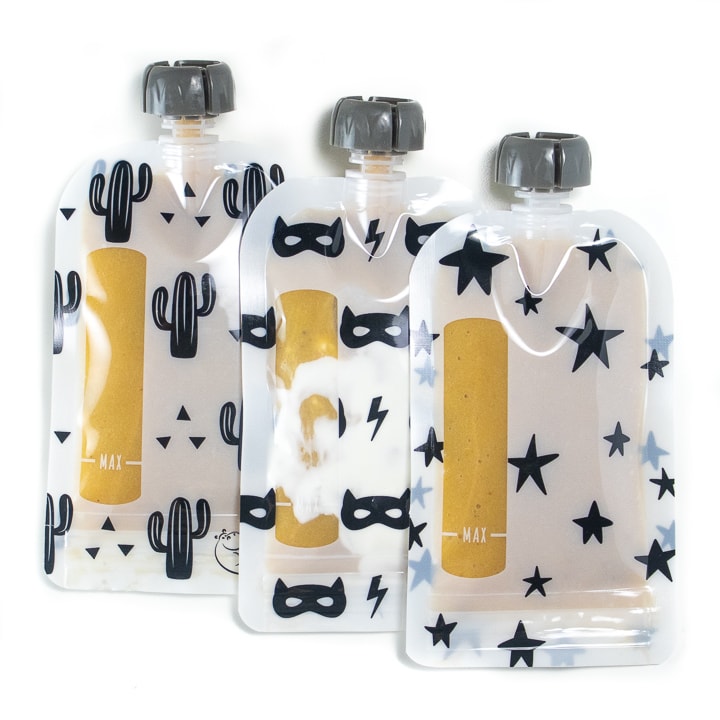
Purees and Choking
Babies are less likely to gag or choke on purees compared to solid foods. When babies showtime suck on the breast or canteen, they are learning how to swallow liquids. Transitioning to purees can help teach your baby an effective swallowing technique, past propelling foods backward with the tongue and swallowing.
How to Keep Infant Safe
As a parent of 2, I know how scary it can be to introduce solid foods to your baby. With the proper precautions and knowledge, the fears volition loosen and feeding your baby tin become a wonderful adventure for both of you.
- Always supervise with food– sit with your babe and try non to multi-chore while your baby is eating.
- Babe should be sitting in an upright position for all meals and snacks, not reclined. If your baby starts to get sleepy during eating, remove nutrient.
- No eating in the car seat unless an adult is in the backseat supervising your babe.
- Do not permit babe eat on the go.Once your baby is crawling or walking, avoid letting them move around with food in their rima oris or holding food in their easily.
- Cheque the temperature of foods before offering them.
- Check baby's mouth after they are done eating. Some babies may pocket food in the sides of their cheeks or get food stuck to the roof of their oral fissure equally they are learning to eat. If you encounter any food remaining, encourage your babe to keep chewing, spit information technology out if they need to, or accept sips of water or milk. Avoid sticking your finger in your baby'due south mouth to become the food out – we desire baby to learn how to manage taking care of the food.
How to Teach Babies to Chew
When babies get-go start chewing, the motion y'all come across is a basic up and down jaw movement, sometimes called munching, that will somewhen progress into a mature chewing design, called rotary chewing. Throughout this process, babies are also developing side-to-side natural language movements, called tongue lateralization. Tongue lateralization helps your babe push food over to their gums, where the molars will somewhen come up in, and where the heavy work of chewing happens. Equally your infant chews the food multiple times, it forms into a little brawl or "bolus" of food, which is so transferred to the back of the mouth for swallowing.
Purees tin likewise be used to develop the skills needed for chewing. You tin identify a spoonful of puree to the sides of the mouth as you lot would with a teether or soft slice of food. The purpose of this is not to wait your baby to starting time "chewing" the puree in the way that we recall of chewing as adults, but rather to encourage your baby to start working natural language lateralization.

Oft Asked Questions
How many o unces will b aby a ctually e at?
This varies with each baby so information technology merely depends! Some babies will only have a taste and be done, and others will desire more and more. Some babies have a larger appetite than others then information technology'south difficult to know merely start with one teaspoon and work your way up to a tablespoon, and then more if your baby is yet interested. Infant volition consume more every bit they go older but always pay attention to your baby's hunger and fullness cues to know when to stop feeding.
How many ounces of purees should baby due eastat?
By the time baby is ready for finger foods, she should be eating around 4 ounces of food at each meal. If it is more or less than this, practise not worry. Babies get almost of their nutrition from formula or breast milk until they turn ane twelvemonth old.
Does baby need teeth to eat?
The question of how babies can chew foods without teeth makes whatever parent scratch their heads! But in reality, we all chew nutrient with our back molars, not our front teeth, which baby doesn't get until 18-22 months of age. Good thing babies have super tough and strong gums, which they use to brew, gnaw and chew foods. Baby's gums are ameliorate at chewing food than you would think, and your baby will be able to chew more foods the older they get, even without their molars.

Can you thousandnine baby-bed weaning and purees?
Admittedly! Both purees and solid foods are great ways to innovate your babe to new flavors and textures. Babies actually learn to swallow liquids get-go, whether in the course of breastmilk or bottles. Purees are like to offering liquid that'south been thickened a bit, and so this can help with introducing your baby to a texture alter and getting practice with swallowing solid food. Only consider limiting the amount of times y'all switch dorsum and forth between soft solids and purees during each repast, at least when your babe is get-go learning to eat. Instead, you could offer a veggie puree as the "appetizer" earlier soft solids at one meal, or yogurt as the "dessert" at another meal.
Puree Feeding Tips
- Relax: try to relax and don't worry also much about how much baby eats. It should be fun for you and baby.
- Timing: babies tend to tolerate purees all-time 1 hour breastfeeding or bottle, when they aren't too hungry or besides full.
- Limit distractions: turn off screens, put away toys, and sit downward confront to face up with infant during the repast.
- Follow babe's lead: it can be piece of cake to overfeed when using traditional weaning vs baby led weaning, so e'er follow babe'southward cues for when they are washed eating. Turning abroad from the spoon, closing his mouth, or pushing food away are all signs that infant is finished with the repast.
- First with a small amount: and small servings. one-2 oz of food per meal is adequate. Remember, these servings will be smaller than yous call back and at this phase, breast milk or formula will withal be your baby's primary source of calories and diet.
- Offer the spoon and allow waiting time: after you bring the spoon toward baby'due south rima oris, look for her to open up and accept information technology. Permit baby to shut her top lip and suck puree off the spoon, while you guide the spoon straight out of the mouth. Avoid scraping the spoon on the roof of the mouth equally you bring information technology back.
- Utilise shallow spoons or flat spoons: these assist baby with immigration puree off with the pinnacle lip. A couple options we love include Olababy and ezpz mini spoon.
- Requite fourth dimension to do: at first y'all might detect baby pushing the food dorsum out and and then swallowing. With fourth dimension and do, this forward/backward reflexive motility with the tongue will fade and baby will outset swallowing more food than he pushes back out.
- Have a back spoon (or two!): even very young babies may want to be involved in the process as much equally possible. Giving baby an extra spoon to agree can be helpful in giving babe sense of control and promoting hand-middle coordination.
- Let baby become messy! Encourage touching and playing with purees for a full sensory experience.
Or watch a shortened version of this video here.
Make Infant Food
-
Make infant nutrient puree per the recipe. This could exist past steaming, roasting or sauteing.

Freeze Purees
-
Cascade puree into freezer tray or small baby nutrient jars.
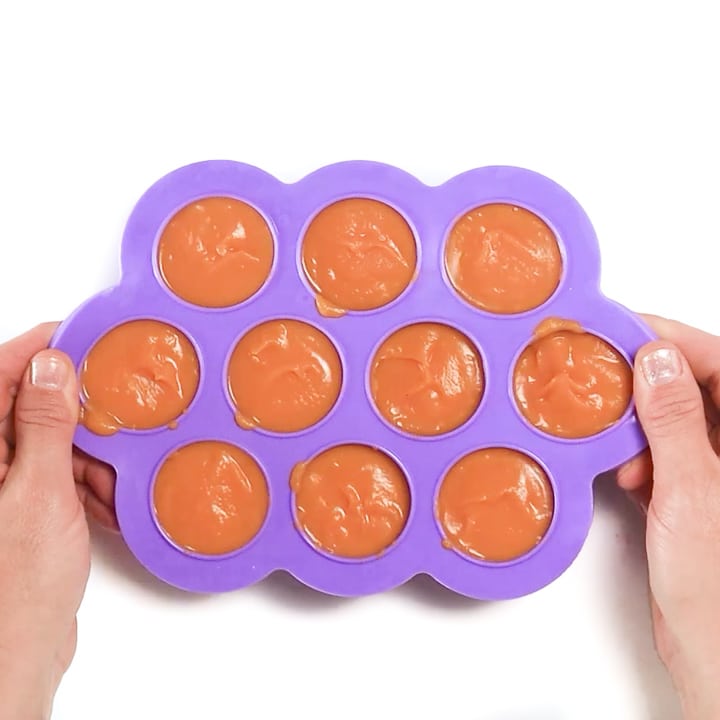
-
Lable the freezer tray or babe food jars with the recipe name and date.
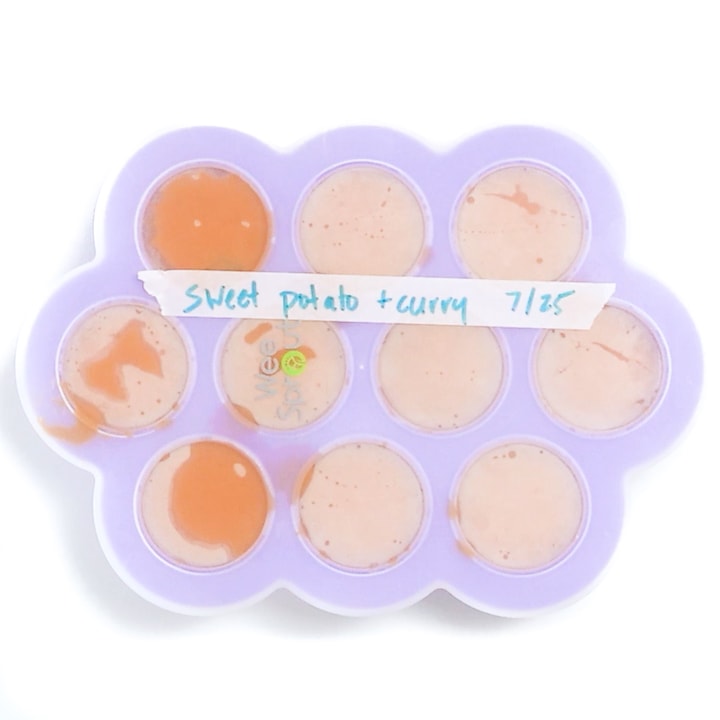
-
Place the tray or jars in the freezer and freeze for at to the lowest degree 5 hours.

-
Pop the frozen infant food cubes out and place them into a zip-lock baggie or stasher pocketbook.
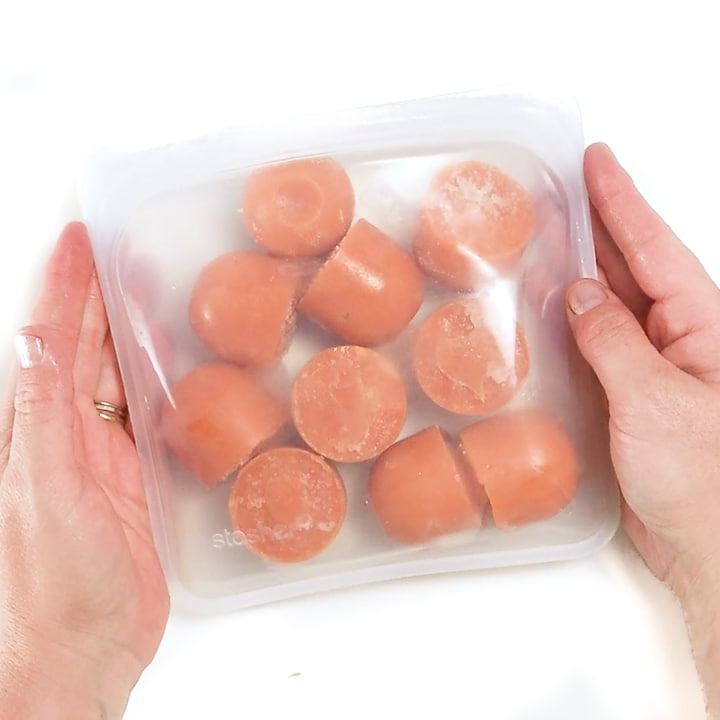
Thaw Babe Food
-
Microwave –
Accept the frozen puree cubes that you desire to serve out of your freezer. Place them in a glass microwave-safe container. Microwave in twenty-2d increments, stirring every time The puree is ready when information technology is but warm to your touch. Grab two clean spoons, i for you and one for your baby, and test your puree earlier serving.
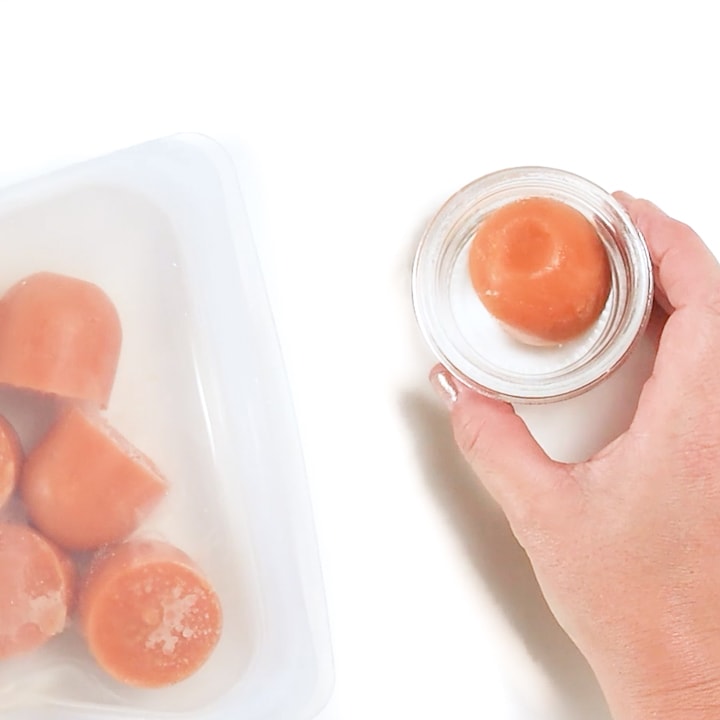
-
Refrigerator –
Take the frozen puree cubes you lot want to serve out of your freezer. Place the cubes in an air-tight glass container. Place the container in the fridge and allow thaw for 12 to 16 hours. Do not leave the puree in the container to thaw on the counter or anywhere out of the fridge, as leaner will start to grow at a rapid charge per unit – which is definitely not good. The puree will be cold only thawed, then if your baby likes her puree warmed, you'll accept to finish the job using the microwave or stovetop method.
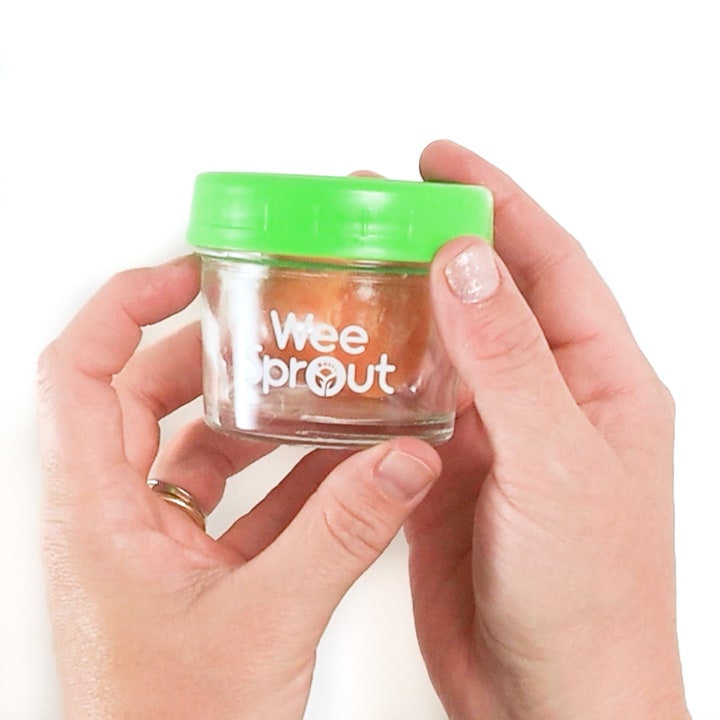
-
Stovetop –
In a small saucepan, add together the frozen puree cubes you want to serve to baby. Over medium-depression heat, gently cook the puree until warm, stirring occasionally.

-
Serve and enjoy!
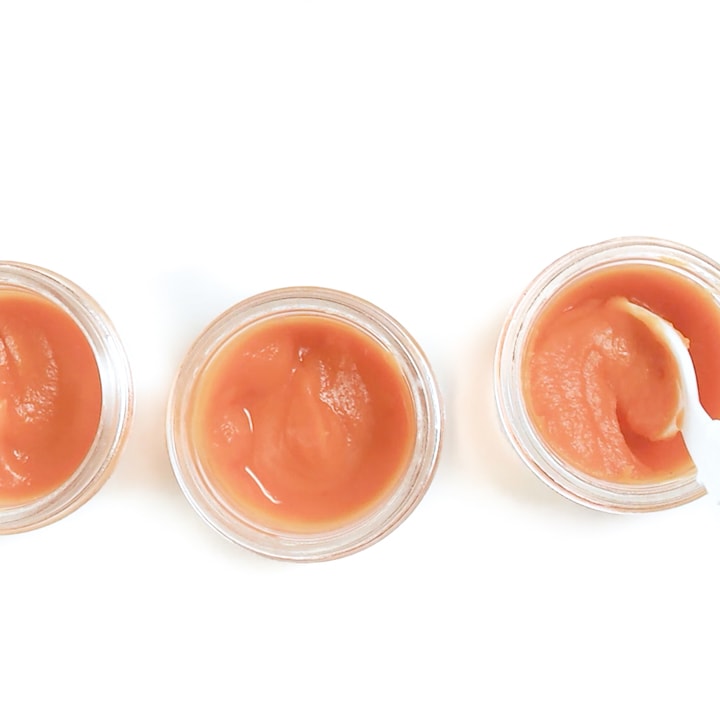
Source: https://babyfoode.com/blog/ultimate-guide-on-how-to-make-and-serve-homemade-baby-food-without-stressing-out-about-it/
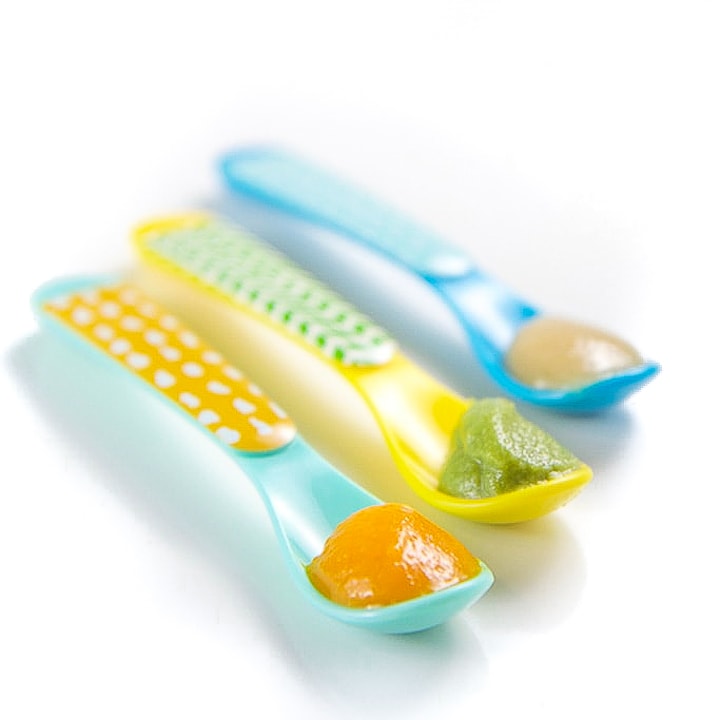
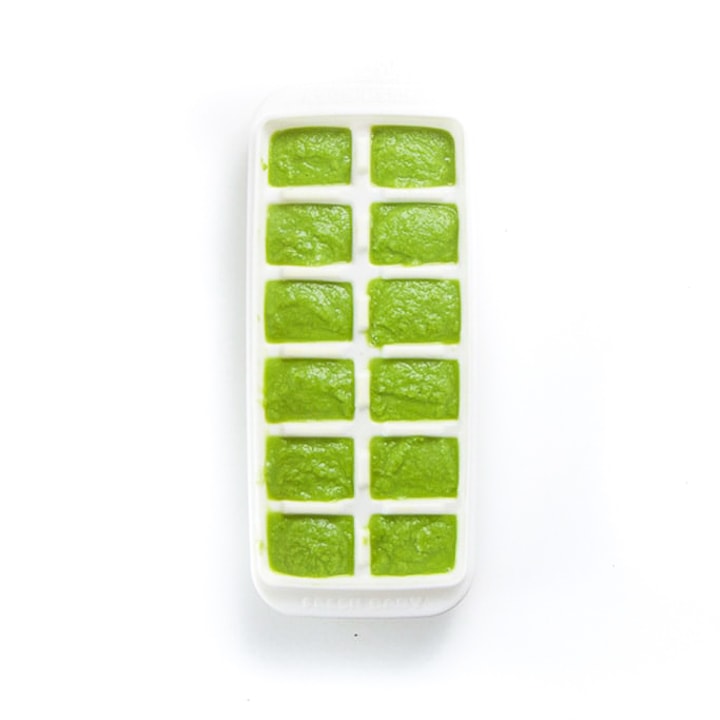
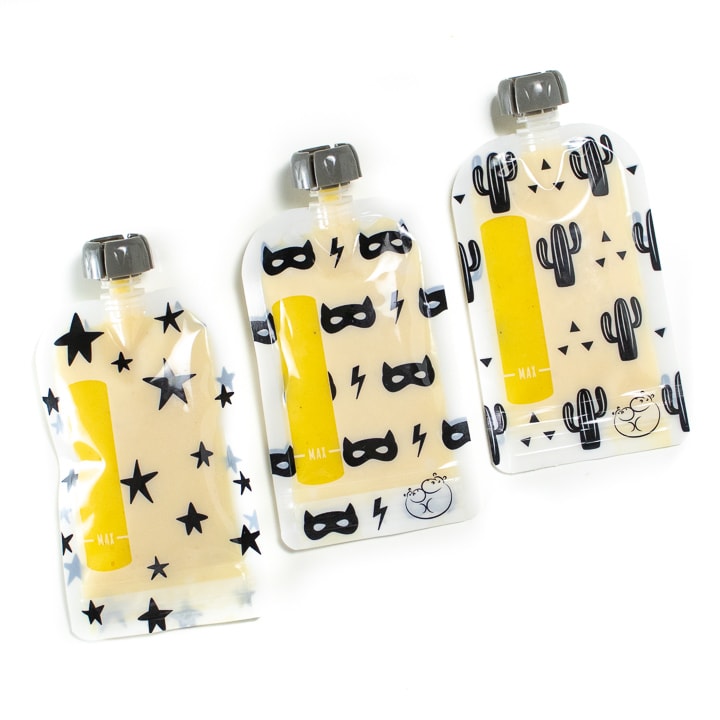
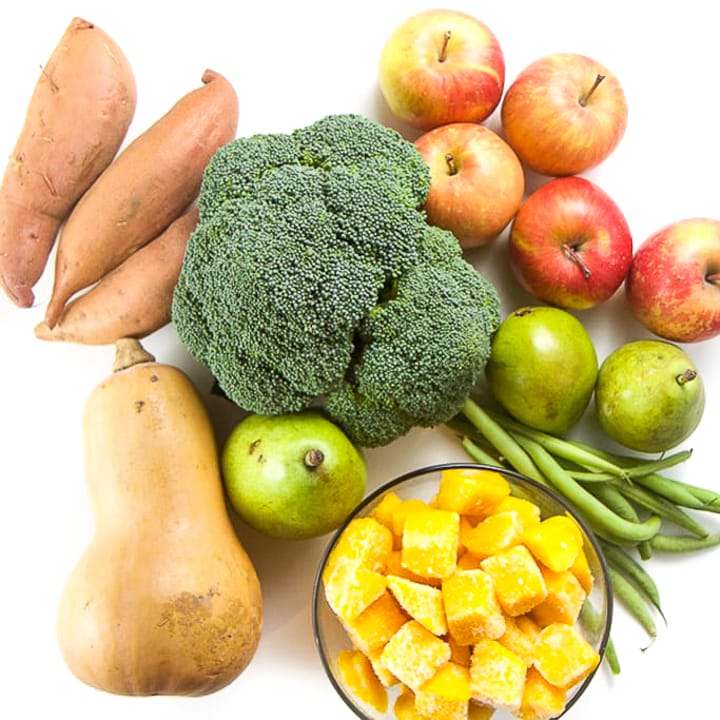
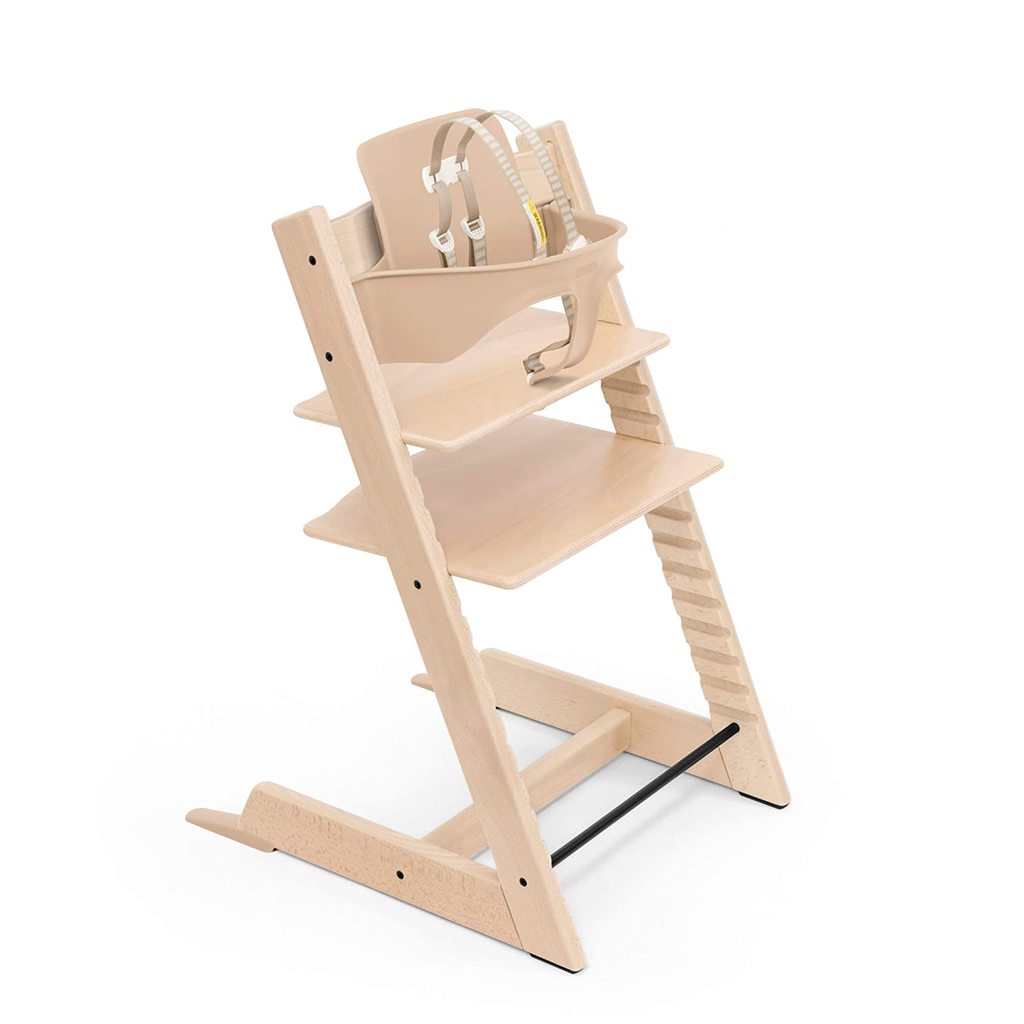
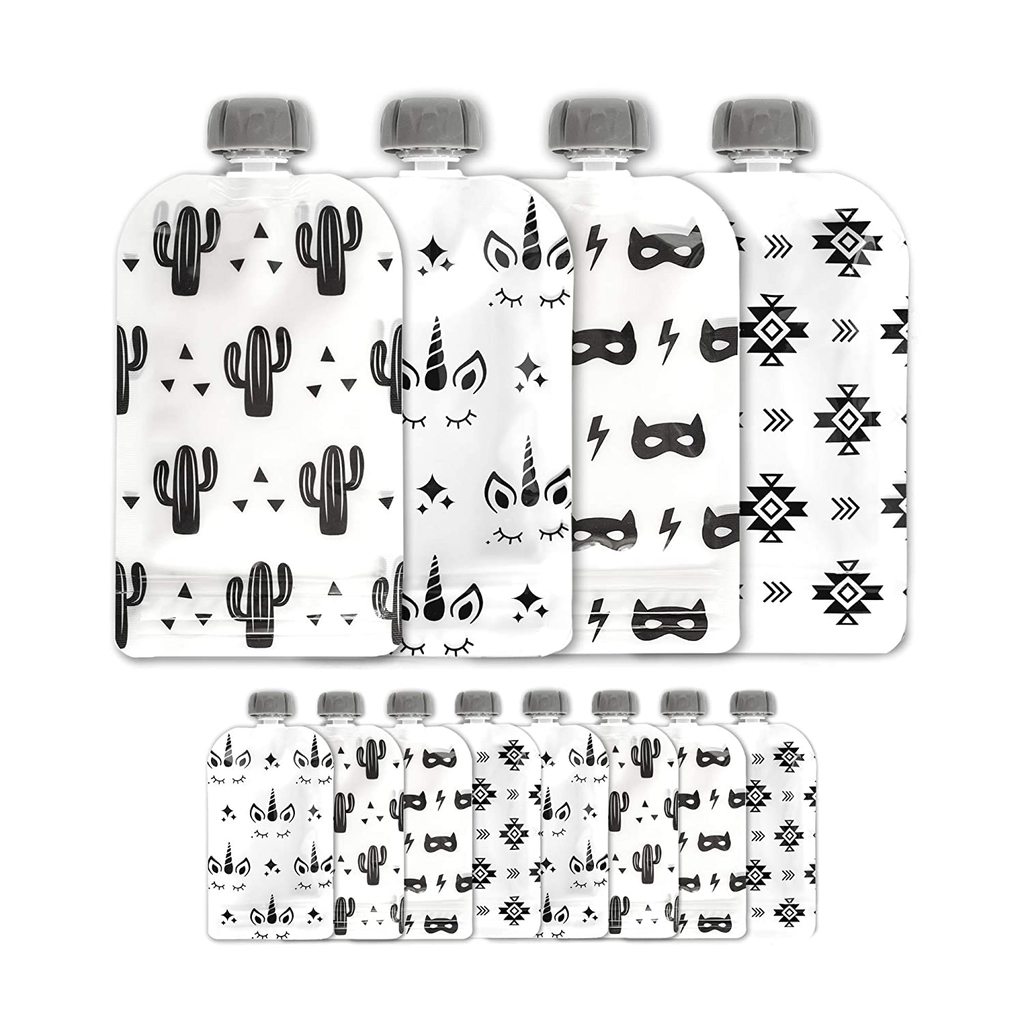
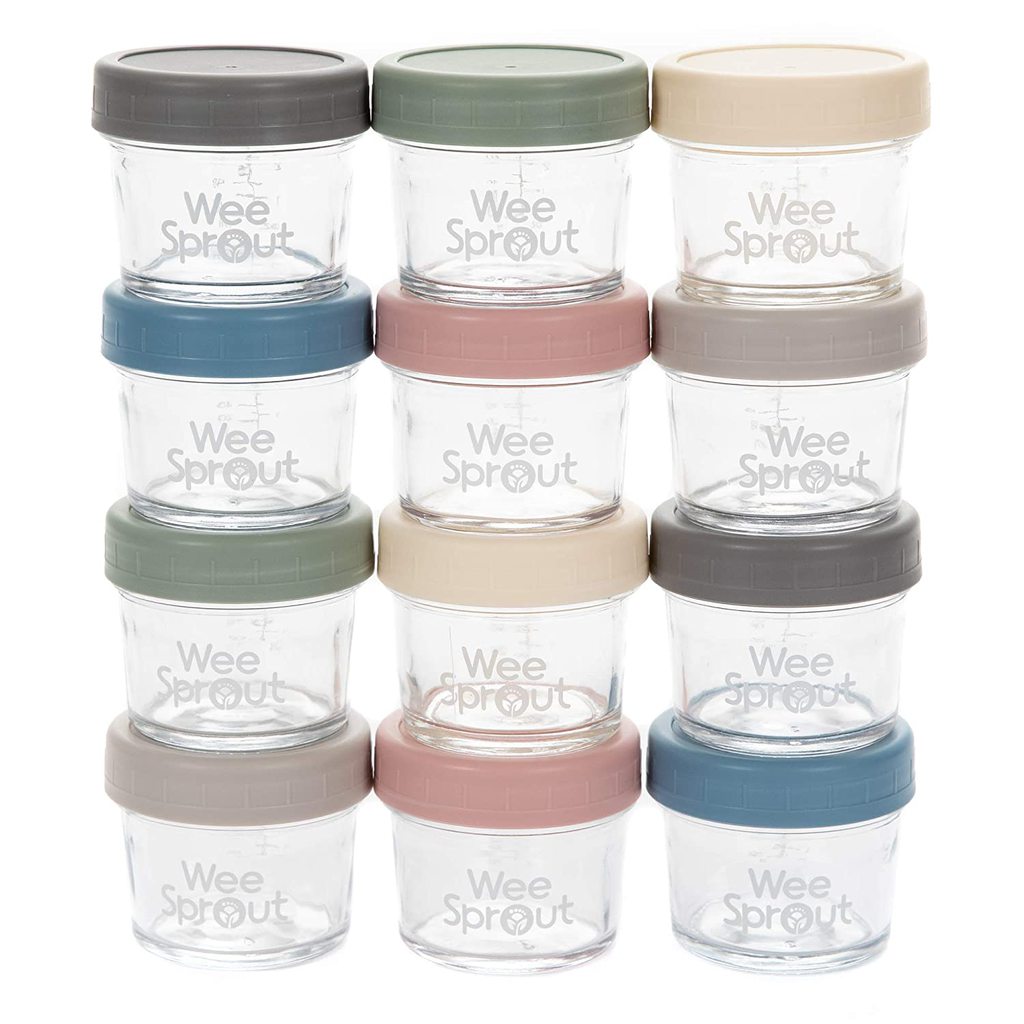
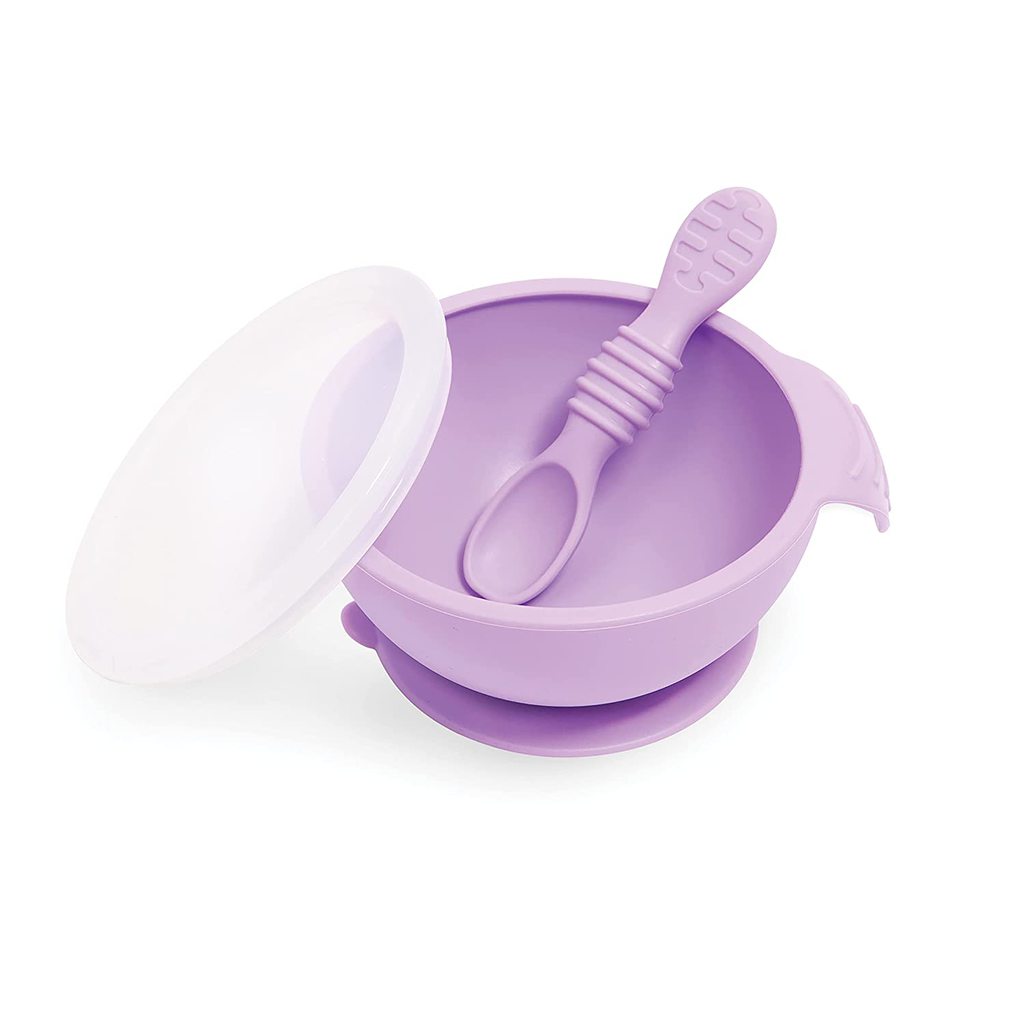
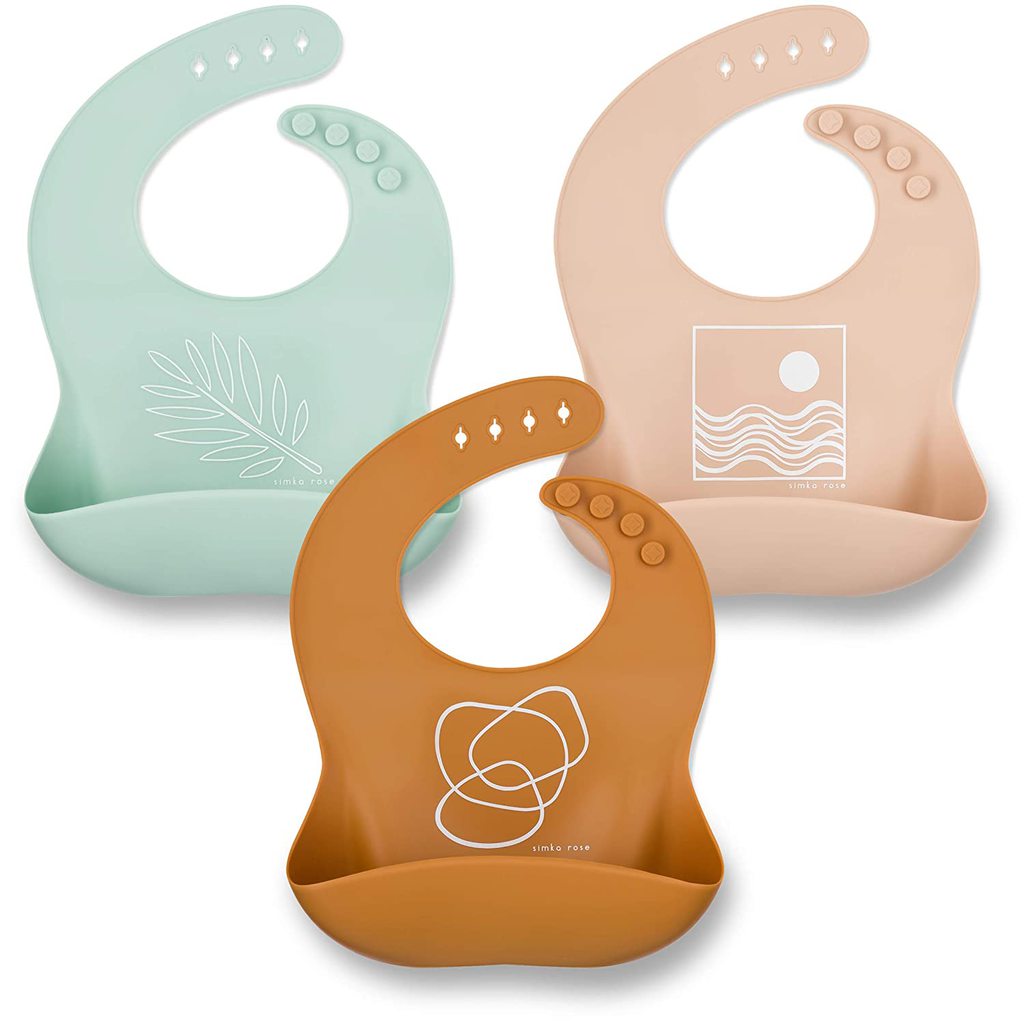
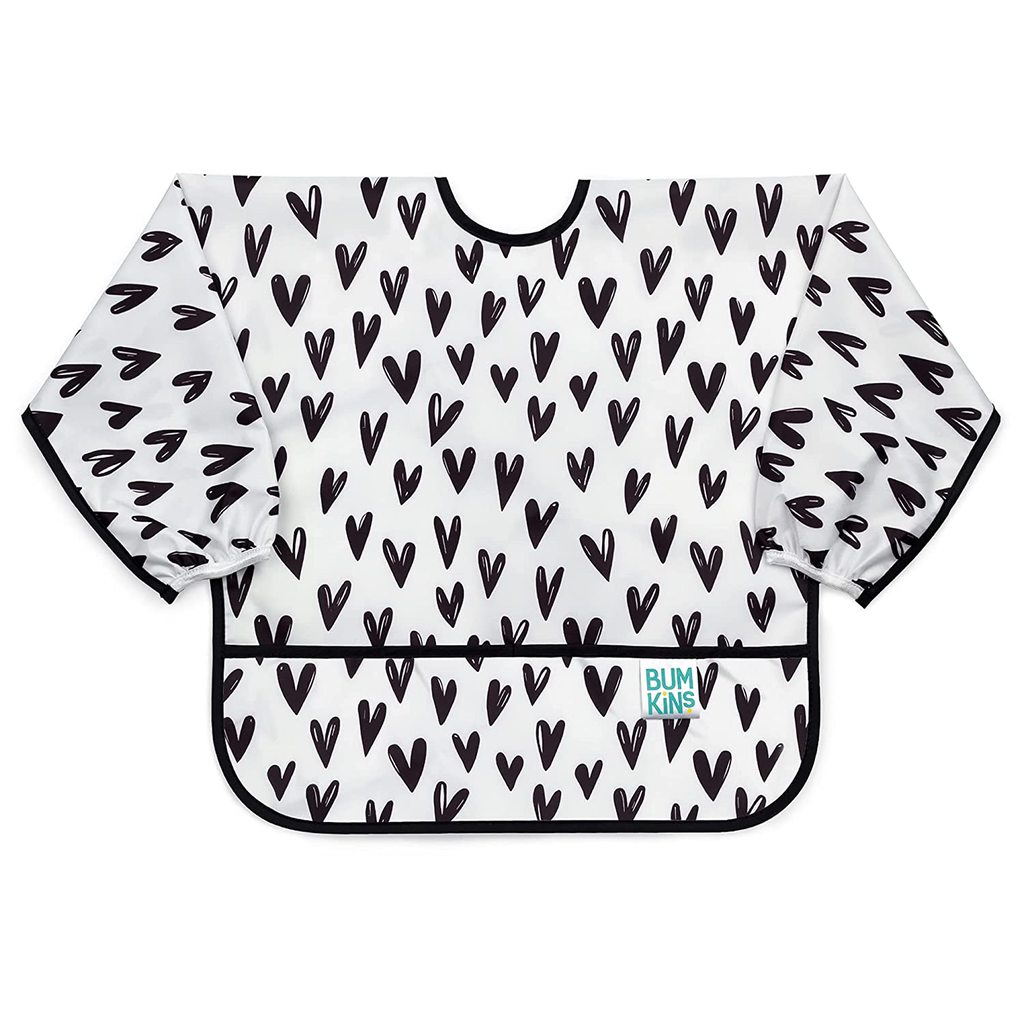
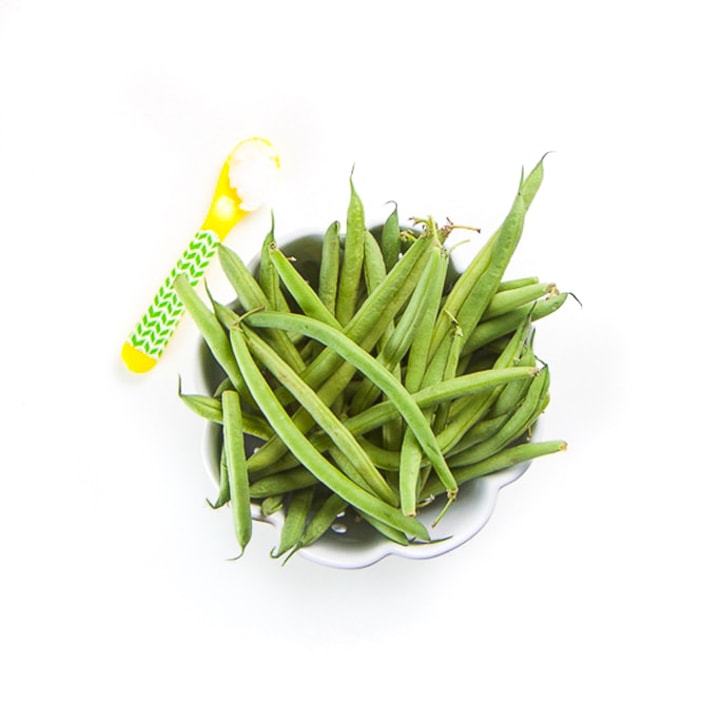
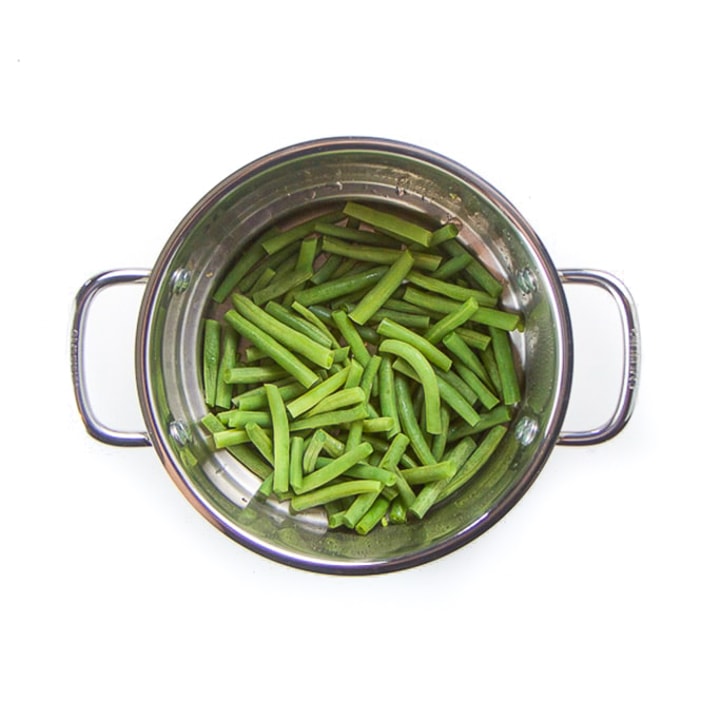
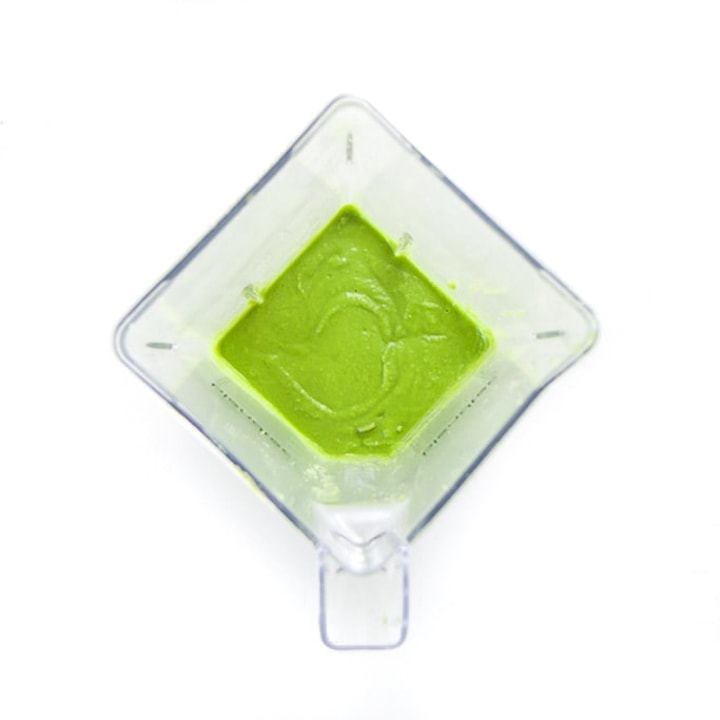
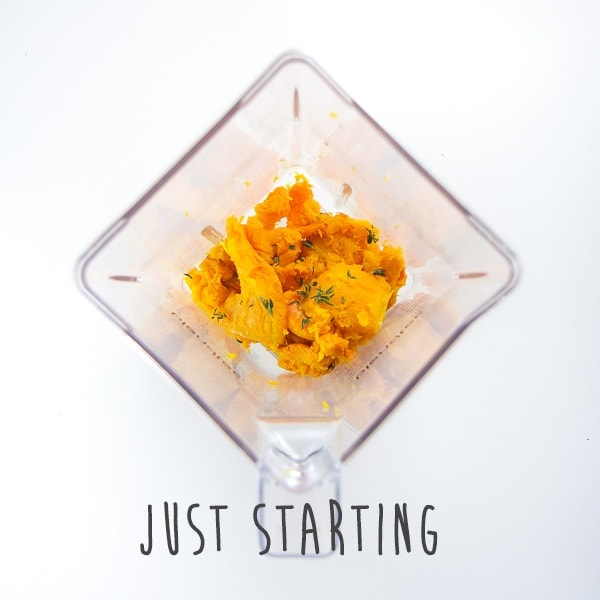
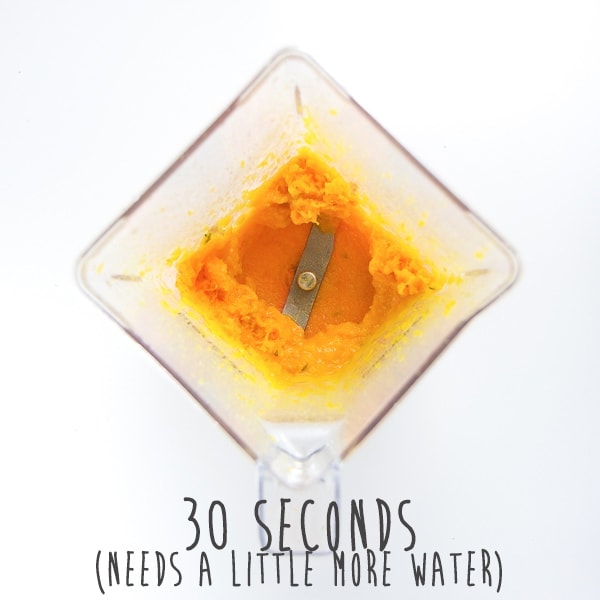
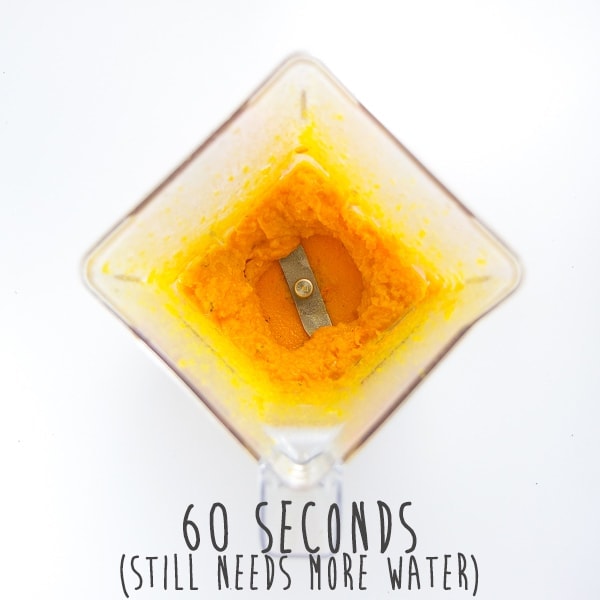
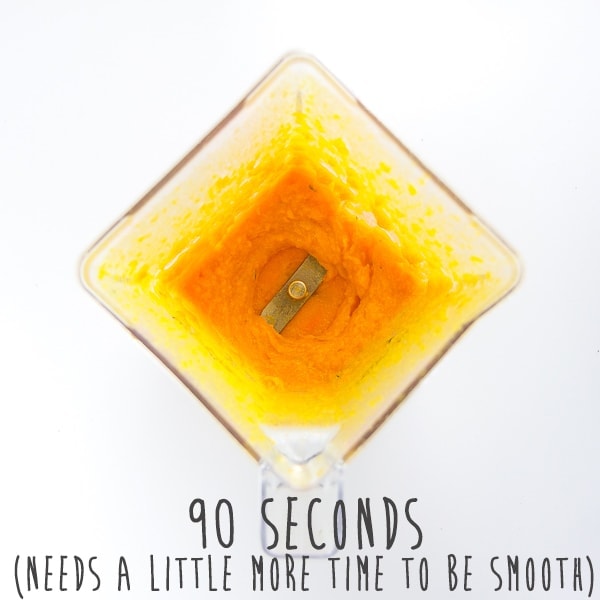
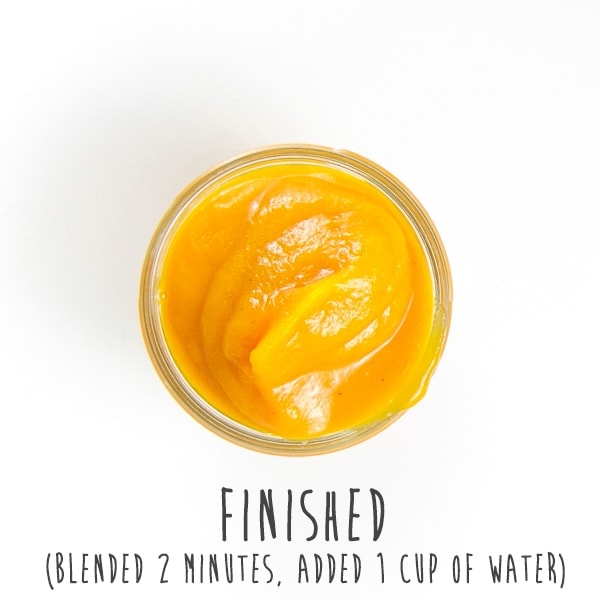


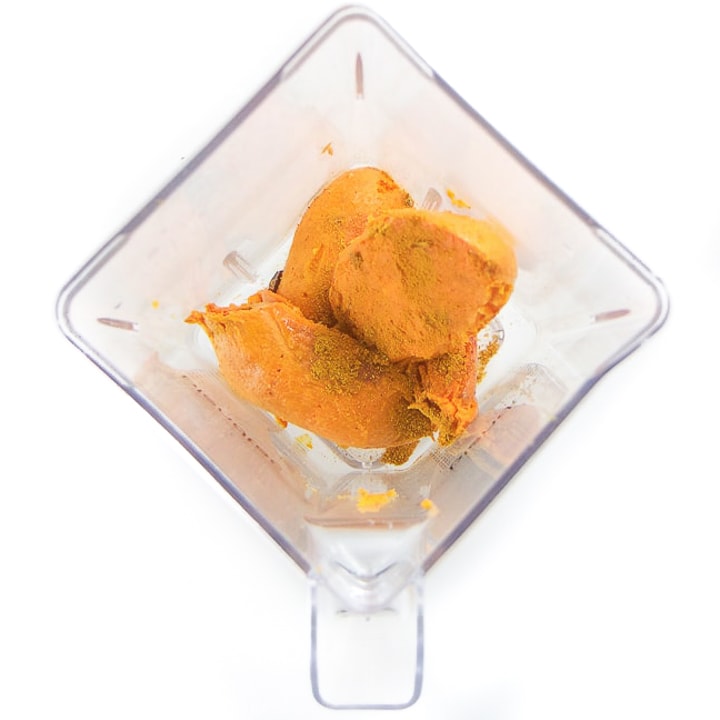
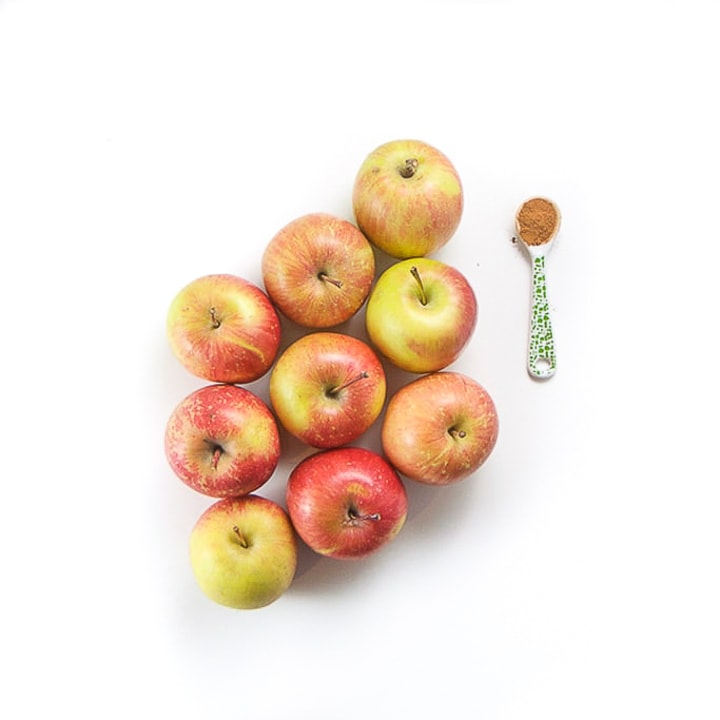
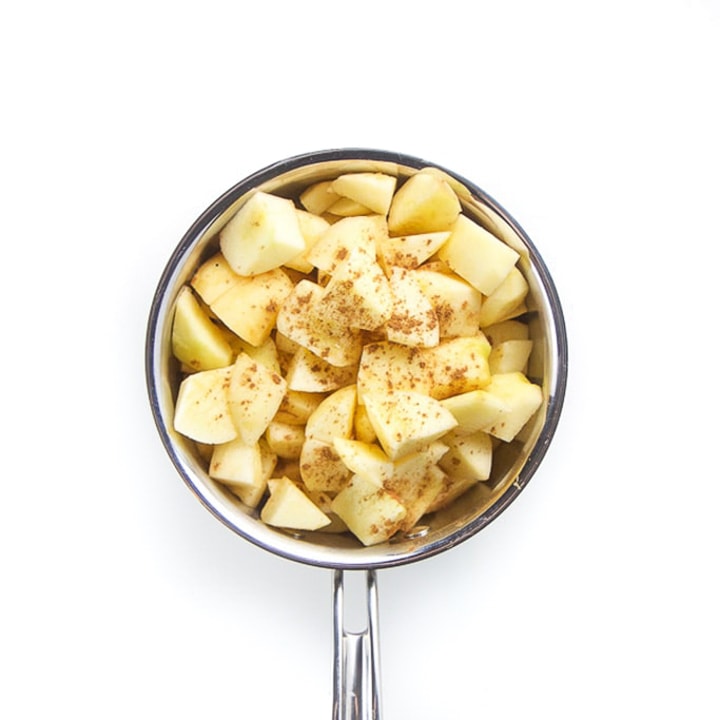

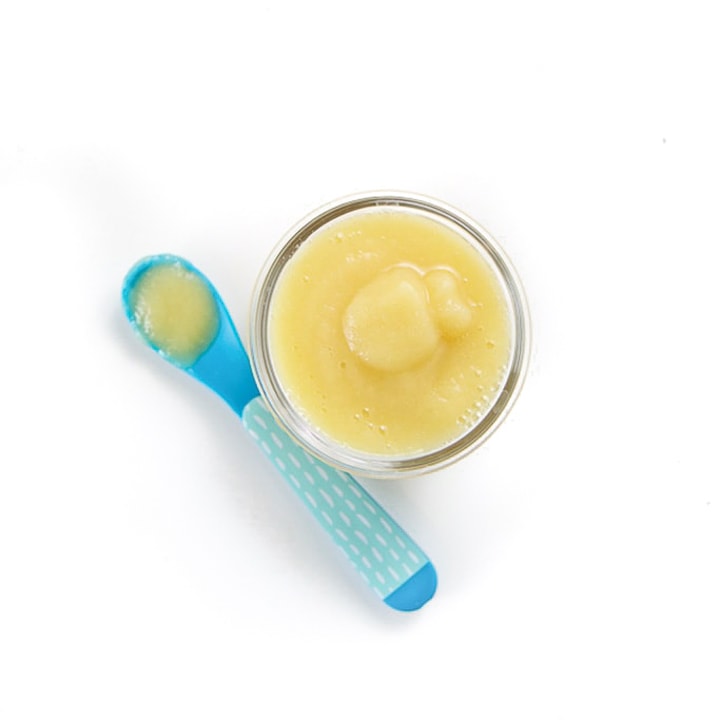
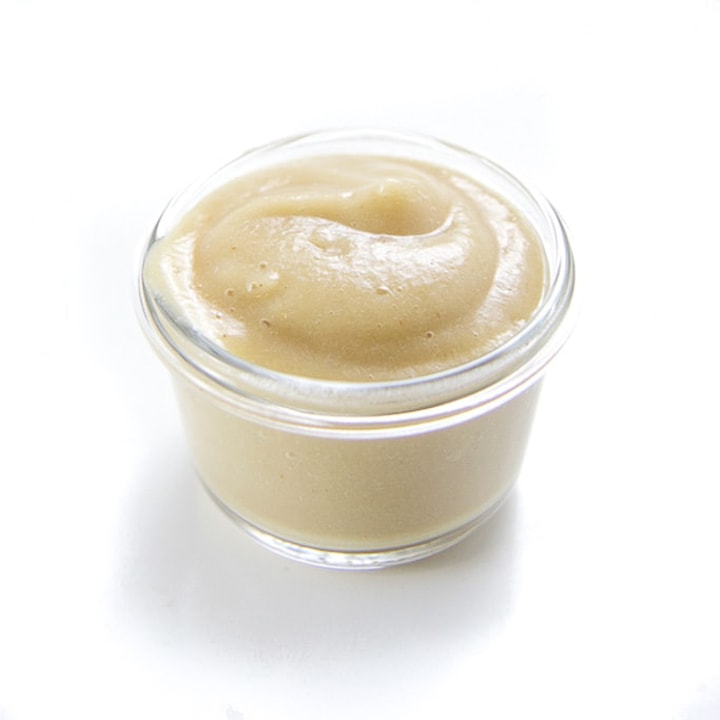

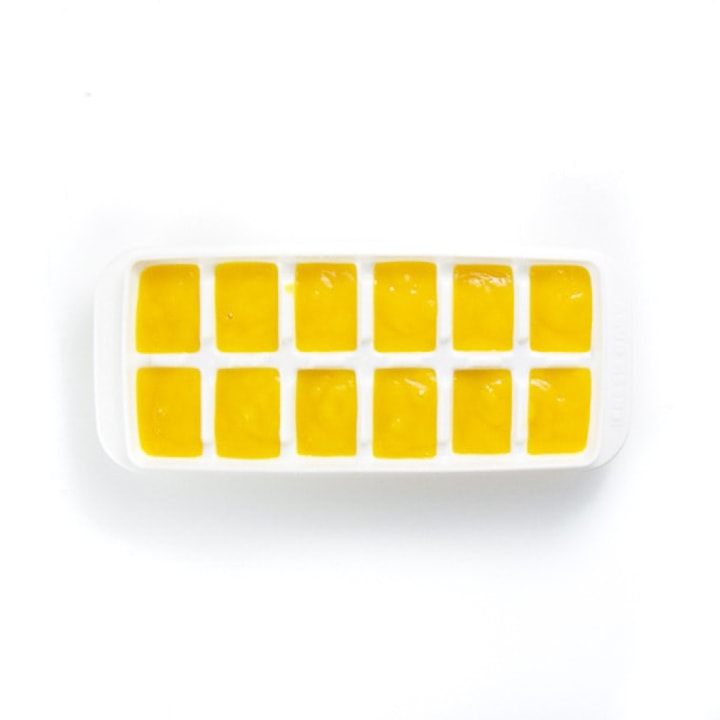

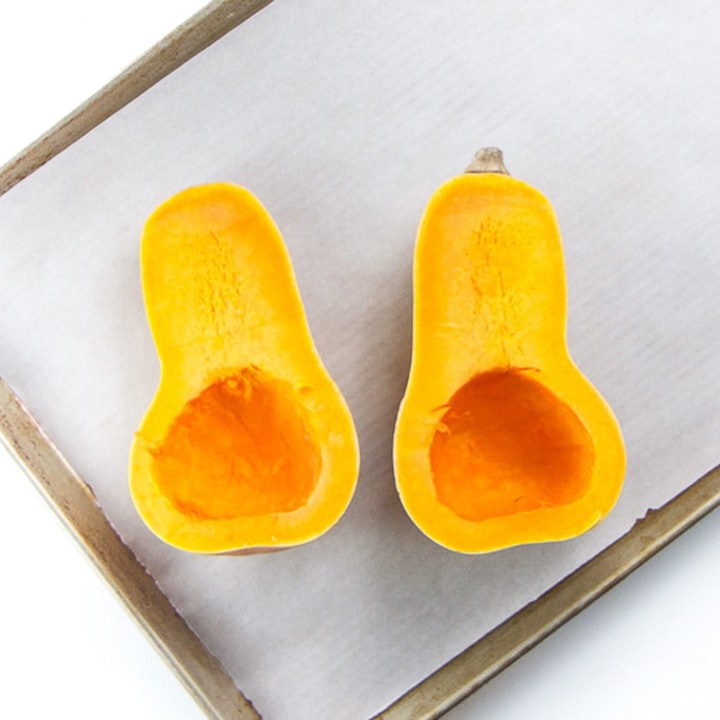

0 Response to "What Techniques Should Be Used When Making Baby Food"
Post a Comment